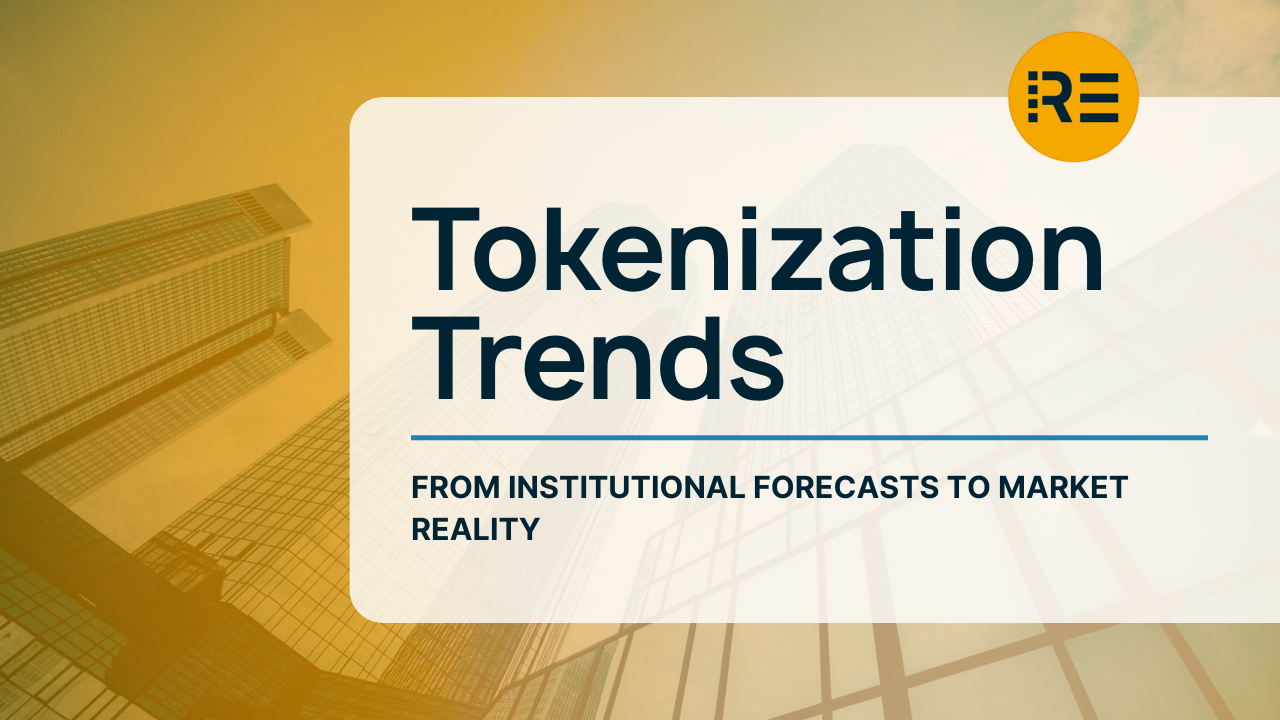Real Estate Tokenization Trends: November 2025 – When Theory Became Practice
If October 2025 was the month when institutional players announced their tokenization ambitions, November 2025 is the month when those ambitions became market reality for key players including the Trump organization.
In just the past week, we witnessed:
- The Trump Organization announcing the world’s first tokenized hotel development project
- Apple introducing digital ID infrastructure that’s blockchain-ready (even if they won’t say it yet)
- Tokenized real estate debt platforms reaching $600K+ TVL in 23 days, showing investor appetite is real
For real estate syndicators who dismiss tokenization as “too early” or “too complicated,” November is demonstrating it’s clear: The market isn’t waiting for you to get comfortable.
This roundup examines three key developments from November 2025 and explains exactly what they mean for your syndication business—whether you’re ready or not.
Trump Organization Goes On-Chain: The Brand Name That Changes Everything
An Announcement That Legitimizes Tokenization for Mainstream Investors
(Source: Trump.com)
On November 13, 2025, Dar Global and The Trump Organization announced two historic firsts:
Trump International Hotel Maldives (the brand’s first project in the Maldives)
The world’s first tokenized hotel development project
Read the full announcement: Dar Global and Trump Organization Announce World’s First Tokenized Hotel Development
Why This Matters More Than You Think
Set aside your political opinions for a moment. From a pure market-signaling perspective, this announcement is seismic.
Here’s why:
Brand recognition: Love or hate the name, “Trump” is one of the most recognized real estate brands globally. When that brand attaches itself to tokenization, millions of investors—many who’ve never heard of blockchain—suddenly become aware that “tokenized real estate” is a real thing.
Mainstream credibility: The Trump Organization isn’t a crypto startup or PropTech experiment. It’s a traditional real estate development company with decades of history. Their move signals to traditional real estate investors: “This isn’t fringe anymore.”
Proof of concept at scale: This isn’t a pilot program or test case. It’s a full-scale international hotel development using tokenization as a core fundraising and ownership structure.
Regulatory confidence: You don’t announce the “world’s first tokenized hotel development” unless your legal team has confirmed that regulatory frameworks support it.
What This Means for Syndicators
The Trump Organization just did something most syndicators are still afraid to do: They publicly committed their brand reputation to tokenized real estate.
Think about that for a moment.
Traditional real estate developers are notoriously conservative. They don’t adopt unproven technology. They don’t risk brand equity on experimental structures. And they certainly don’t announce “world’s firsts” unless they’re confident it will work.
The fact that a major brand is willing to stake its reputation on tokenization sends three clear signals:
The technology works: Infrastructure is mature enough for institutional-scale projects
The regulatory path exists: Legal frameworks support tokenized offerings
The market demand is real: Investors want tokenized real estate exposure
For syndicators, the Trump Organization announcement creates an interesting dynamic: Your LPs will now ask, “If Trump can tokenize a hotel development in the Maldives, why can’t you tokenize our multifamily syndication in Texas?”
And honestly, that’s a fair question.
REtokens Take:
The Trump Organization’s move represents the exact inflection point that separates “early adopters” from “late majority.”
Early adopters tokenize BEFORE major brands validate the model—and capture first-mover advantage.
Late majority waits FOR major brands to validate the model—and fights for market share in an increasingly crowded space.
The uncomfortable reality: If you’re reading this announcement and thinking “I should look into tokenization,” you’re already behind the syndicators who are actively tokenizing deals right now.
The Trump Organization didn’t wait for “one more case study.” They didn’t wait for “absolute regulatory clarity.” They didn’t wait for “all the infrastructure to be perfect.”
They recognized an opportunity, assessed the risks, and moved.
The question is: Will you?
Apple’s Digital ID: The Infrastructure Everyone Missed
When Tech Giants Build Blockchain-Ready Systems (Without Saying “Blockchain”)
(Source: CoinGeek)
Apple recently introduced digital ID functionality—and most people completely missed the tokenization implications.
Read the full analysis: Apple Introduces Digital ID—Why It Should Live on Blockchain
The Announcement (And What Apple Isn’t Saying)
Apple’s digital ID allows users to store government-issued identification on their iPhone and Apple Watch. Currently, it’s being rolled out for driver’s licenses and state IDs in select U.S. states.
Here’s what Apple IS saying: “Convenient, secure digital identity verification.”
Here’s what Apple ISN’T saying: “We’re building blockchain-compatible infrastructure.”
But that’s exactly what they’re doing.
Why Blockchain Is the Logical Next Step
Apple’s digital ID infrastructure has one critical limitation: centralization. Apple controls the verification, storage, and access protocols.
For everyday consumer uses, that’s fine. But for financial services, real estate transactions, and tokenized asset ownership, centralization creates problems:
Privacy concerns: Why should Apple (or any company) be the permanent custodian of your identity verification?
Interoperability issues: How do Apple IDs communicate with non-Apple verification systems?
Regulatory complications: Centralized identity systems create single points of failure and regulatory jurisdiction questions.
Verification permanence: Tokenized asset ownership requires immutable, decentralized identity verification.
The solution to all of these problems? Blockchain-based digital identity.
What This Means for Tokenized Real Estate
Here’s the connection most syndicators miss: Tokenized real estate requires verified investor identity.
Currently, that verification process is:
- Manual (collecting documents, uploading to portals)
- Redundant (repeating KYC/AML for every investment)
- Inefficient (days or weeks to verify accredited investor status)
- Costly (service providers charge $100-300 per investor verification)
A digital ID infrastructure—once it evolves to blockchain standards—solves all of this.
Imagine:
LP clicks “invest” in your tokenized offering
Their digital ID (stored on blockchain) instantly verifies accredited investor status
Smart contract confirms compliance, executes investment, issues tokens
Total time: 60 seconds
Cost: near-zero
This isn’t science fiction. The infrastructure is being built right now.
REtokens Take:
Apple didn’t announce “blockchain digital ID” because they don’t need to. They’re building the centralized version although, knowing full well that market demands will eventually require decentralization.
Apple’s move signals something crucial: The technology giants are building infrastructure that will make tokenized investing EASIER and more prevalent in the future.
Right now, investing in a syndication requires:
- Finding the deal (manual networking)
- Reviewing offering documents (PDFs, emails)
- Completing investor verification (forms, uploads, waiting)
- Wiring funds (bank delays, wire fees)
- Receiving confirmation (days later)
In the blockchain-enabled environment:
- Finding the deal (platform discovery)
- Reviewing offering documents (digital, with verified data)
- Completing investor verification (immediate, via digital ID)
- Investing funds (trade similar to stocks or crypto)
- Receiving tokens (immediately, tradeable on secondary markets)
The syndicators who recognize this aren’t just adopting new technology—they’re positioning themselves for the digital ID infrastructure today.
The question is whether you’ll be ready.
CoinLander: The $600K Proof Point Nobody Expected
Tokenized Real Estate Debt Attracts Serious Capital—In 23 Days
(Source: Business Insider Markets)
While major institutions announce tokenization plans and tech giants build infrastructure, a relatively unknown platform just proved something crucial: Real investors are deploying real capital into tokenized real estate—RIGHT NOW.
Read the full story: CoinLander Surpasses $600K TVL in 23 Days
The Numbers That Tell the Story
CoinLander, a tokenized real estate debt platform, achieved:
$600,000+ Total Value Locked (TVL)
23 days from launch to $600K milestone
Strong ongoing investor demand signaling product-market fit
For context, that’s roughly $26,000 per day in new investment—consistently—for three straight weeks.
Why This Matters More Than Institutional Announcements
BlackRock’s tokenization announcements are significant. Deloitte’s $4 trillion forecasts are important. But CoinLander’s $600K milestone is arguably MORE significant for syndicators.
Here’s why:
Institutional announcements are future-focused: BlackRock is building infrastructure for “the next tens of years.” That’s great—but it doesn’t help you raise capital in 2025.
CoinLander’s TVL is present-tense: Real investors are deploying real capital into tokenized real estate debt TODAY. Not “someday.” Not “when regulations are clearer.” Today.
The market isn’t waiting for perfect conditions. It’s moving now.
The Tokenized Debt Advantage (And What It Means for Equity)
CoinLander focuses on tokenized real estate debt, not equity. That’s significant for two reasons:
- Debt is conservative: If conservative debt investors are comfortable with tokenization, equity investors (who accept higher risk for higher returns) should be even more comfortable.
- Debt proves infrastructure: Debt instruments require precise compliance, automated interest payments, and reliable smart contract execution. If the infrastructure handles debt correctly, it can certainly handle equity.
The fact that $600K flowed into tokenized real estate debt in 23 days signals something crucial: The infrastructure works, investors trust it, and capital is ready to deploy.
What This Means for Syndicators
CoinLander’s rapid TVL growth destroys the three most common objections syndicators have about tokenization:
Objection 1: “Investors aren’t ready for tokenization.”
Reality: $600K deployed in 23 days proves investors are not only ready—they’re actively seeking tokenized offerings.
Objection 2: “The technology isn’t proven.”
Reality: Platforms are processing real transactions, managing real compliance, and distributing real returns.
Objection 3: “It’s too early.”
Reality: While you’re waiting for “the right time,” your competitors are positioning themselves for capturing market share.
Here’s the uncomfortable truth: Every day you wait to explore tokenization, the market –with platforms like CoinLander — YOUR potential LPs are being educated on tokenized real estate investing.
And when those LPs understand that tokenized offerings provide:
- Enhanced liquidity through secondary markets
- Lower investment minimums via fractional ownership
- Automated distributions and transparent reporting
- Real-time global access to investment opportunities
…they’re going to start asking why your syndications don’t offer the same advantages.
REtokens Take:
CoinLander’s success reveals something most syndicators miss: You’re not competing for attention with other syndicators anymore. You’re competing with tokenized platforms that offer structural advantages your traditional syndications can’t match.
Consider the competitive dynamics:
Traditional Syndication:
- $50K-$100K minimums
- Complete illiquidity until exit
- Wire transfers and manual processing
- Document-heavy subscription process
- No secondary market access
Tokenized Offering:
- $1K-$25K minimums (or lower in many cases)
- The potential for secondary market liquidity
- Digital investment and instant settlement
- Streamlined KYC/AML via verified identity
- Trade on compliant exchanges on your time
The syndicators who recognize this aren’t panicking—they’re partnering with companies like REtokens to scale and grow.
The syndicators who ignore this are hoping investor demand for liquidity and accessibility magically disappears.
Spoiler alert: It won’t.
The Pattern You Can’t Ignore Anymore
October 2025 gave us institutional validation. November 2025 gave us market proof and now based on November’s developments; the syndication market is rapidly segmenting into three tiers:
Tier 1: Tokenization Leaders
Syndicators actively tokenizing offerings, capturing first-mover advantage, and positioning as innovators in their markets.
Tier 2: Tokenization Explorers
Syndicators researching platforms, understanding the model, and preparing to tokenize their next offerings.
Tier 3: Tokenization Skeptics
Syndicators dismissing tokenization as “too early,” “too complicated,” or “not relevant to my LPs.”
Here’s the opportunity: Tier 1&2 have a chance to innovate and lead, while tier 3s may become obsolete.
What Every Syndicator Should Do This Week
The gap between “aware of tokenization” and “actively tokenizing” is measured in months, not years. Here’s what forward-thinking syndicators are doing right now:
Step 1: Stop waiting for “perfect clarity.” The Trump Organization didn’t wait. BlackRock didn’t wait. Your competition isn’t waiting.
Step 2: Schedule a consultation with a compliant tokenization platform. Understand the process, timeline, and costs. Get real answers to replace assumptions.
Step 3: Model your next deal as tokenized offering. Compare traditional vs. tokenized economics. Understand the actual trade-offs.
Step 4: Talk to your existing LPs. Ask if they’d value secondary market liquidity, lower minimums, and digital access. Their answers might surprise you.
Step 5: Make a decision. Lead or Follow? Up to you—but don’t pretend the market isn’t moving.
REtokens Take: The Window Is Closing
November 2025 marks a critical inflection point. The distance between “institutional interest” and “market standard” is collapsing faster than most syndicators realize.
Remember: TD Ameritrade didn’t replace stock trading overnight. But within a decade, traditional brokerages were either digitized or extinct.
You have the same choice those brokers had—except you have one advantage they didn’t: You can see how this story ends.
The Trump Organization is tokenizing hotels. Apple is building blockchain-ready infrastructure. Platforms are attracting capital at rates that prove investor demand.
The question isn’t whether tokenization becomes standard in real estate syndications.
The question is whether you’ll be positioned as a leader when it does—or scrambling to catch up when your LPs start asking why your competitor’s offerings include liquidity and yours don’t.
The market is moving. The question is: Are you?
Tokenize your real estate here




